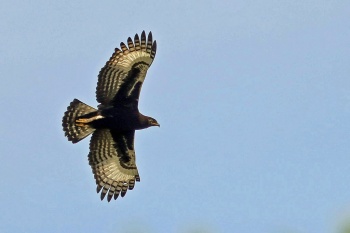- Lophaetus occipitalis
Identification
50–58 cm (19¾-22¾ in)
- Dark brown or black overall plumage
- Broad rounded wings
- White patches at the joint of the wing both above and below
- White under-wing coverts spotted with black
- White base to the tail
- Golden to reddish brown eyes
- Yellow cere and feet
Immatures can be differentiated from the adult by the neck feathers having whiter tips, a less noticeable crest, and a more mottled appearance. The eyes are dark olive-brown, the feet and cere pale ochre-yellow.
Distribution
Sub-Saharan Africa: widespread from Senegal east to Ethiopia and south to Angola and the Cape. Absent from the most arid areas of the Horn of Africa and the south-west.
Taxonomy
This is a monotypic species[1].
Habitat
Woodland, forest edge and plantations, cultivated areas with trees and swampy grasslands, from sea-level up to 3,000m.
Behaviour
Diet
The diet consists mostly of small rodents and shrews in addition they will also eat lizards, small snakes and small mammals.
Breeding
They generally lay during the wet season. Both adults construct the nest in a tree, about two feet across by a foot deep; made of small sticks, and with a deep central cup about one foot across, lined with green leaves. The clutch contains 1-2 white eggs, marked brown, grey, lilac, which are incubated by the female.
Movements
Resident and in some areas, nomadic.
References
- Clements, J. F., T. S. Schulenberg, M. J. Iliff, D. Roberson, T. A. Fredericks, B. L. Sullivan, and C. L. Wood. 2018. The eBird/Clements checklist of birds of the world: v2018. Downloaded from http://www.birds.cornell.edu/clementschecklist/download/
- Avibase
- Handbook of the Birds of the World Alive (retrieved May 2019)
Recommended Citation
- BirdForum Opus contributors. (2025) Long-crested Eagle. In: BirdForum, the forum for wild birds and birding. Retrieved 28 March 2025 from https://www.birdforum.net/opus/Long-crested_Eagle
External Links
GSearch checked for 2020 platform.1





